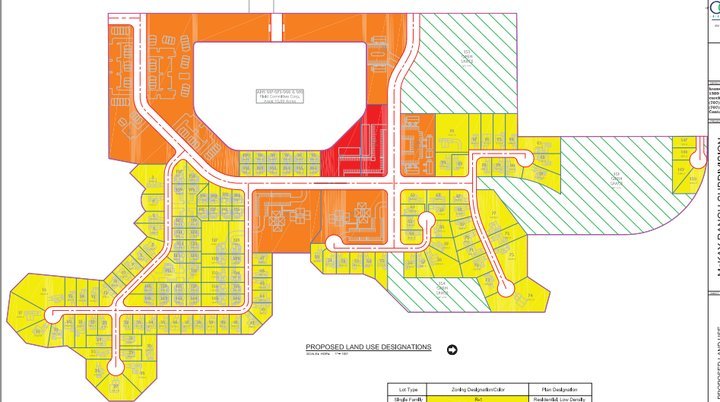
Map of the proposed North McKay Ranch Subdivision. | Click here to view a larger image in pdf form.
# # #
Local environmental groups have begun voicing concerns about a major mixed-use development proposed for the Cutten neighborhood just south of Eureka.
Plans for the 81-acre project, which would encircle the Redwood Fields recreation facility, call for 320 new residential units — both houses and apartments — along with 22,000 square feet of commercial development.
Comments on the project’s Draft Environmental Impact Report must be submitted to the county by next Monday, and some local watchdog groups are already calling the document inadequate.
In a joint letter submitted earlier today, Colin Fiske and Tom Wheeler — executive directors of Coalition for Responsible Transportation Priorities (CRTP) and the Environmental Protection Information Center (EPIC), respectively — say the development as planned would amount to a car-oriented suburb that boosts greenhouse gas emissions.
“Generally, we consider the project location to be less than ideal for housing development, as it is located at the suburban-wildland interface, distant from services and employment centers,” the letter argues. In an email, Fiske told the Outpost that the project also fails to provide for bicycle transportation or connections to public transportation, which will “significantly increase vehicle miles traveled” along with the planet-warming fumes that entails.
“The DEIR falls short in its analysis of all of these topics and fails to provide required mitigation,” Fiske said.
Project applicant Kramer Properties, owned by local developer Kurt Kramer, plans to include nearly 22 acres of undeveloped open space to be dedicated to the county “for future trail management or conveyed in fee,” according to the DEIR.
The project is expected to be constructed in nine phases over the course of 15 to 20 years, depending on market conditions. It would require annexation into the Humboldt Community Services District (HCSD) for water and natural gas services.
In a letter submitted last year, shortly after the project was announced, San Francisco-based environmental nonprofit EarthJustice called for every building to be fully electrified, with no connection to natural gas. “The transition from gas to electric buildings is critical to reaching a zero-emissions future and will not occur at the scale or timing needed absent decisive County leadership,” the letter states.
The group calls on the county to apply a net-zero emissions threshold in recognition of the severity of the climate crisis.
Current plans include underground lines for both electricity and natural gas, though the DEIR boasts of conservation features such as energy-efficient homes equipped with rooftop solar, along with electric vehicle charging stations at all commercial and multi-family units.
Once fully built, the project as currently designed would include 146 single-family houses and 174 multi-family units, including some low-income housing. A water tank would be installed in the undeveloped timberland two-and-a-half miles to the south of the project site.
The DEIR identifies just two “significant unavoidable adverse impacts” — greenhouse gas emissions and wildfires. The houses and apartments don’t leave room for the 100-foot defensible-space buffers required by the California Department of Forestry and Fire Protection (Cal Fire).
In order for the county to certify a Final Environmental Impact Report (FEIR), it would need to provide a statement of overriding considerations. In other words, the Board of Supervisors would have to agree that the benefits outweigh the costs.
County leaders could also choose to go with an alternative plan. The DEIR includes an option of a site plan redesign that would eliminate 10 apartment units and 14 small-lot homes, allowing space for the 100-foot fire buffer. Another redesign option would eliminate 16 of the single-family homes and 24 of the apartment units.
The stated objectives of the project include:
- economic development
- the creation of useful and attractive parks
- new trails
- preserved open space, and
- “a diversity of housing choices” to help meet the county’s ever-increasing housing needs.
The DEIR lists some possibilities for the project’s commercial district, including bakeries, banks, beauty salons, book stores, drug stores, laundromats and restaurants.
There are certain to be other areas of concern from local community members. The DEIR notes some “areas of potential controversy,” including traffic, aesthetics, wildfire danger and impacts to biological resources (Ryan Creek is nearby).
In a letter submitted nearly a year ago, local nonprofit Humboldt Baykeeper, whose mission is to safeguard the county’s coastal resources, expressed particular concern about impacts to the riparian and aquatic habitat in Ryan Creek and its tributaries.
Executive Director Jennifer Kalt wrote, “[I]t can reasonably be argued that the area is inappropriate for further residential and commercial development,” though she notes that the decision to change the land use classification was made a quarter century ago.
The DEIR includes a long list of mitigation measures for the expected environmental impacts, including wetland creation, a carbon offset agreement with the City of Arcata, a stormwater pollution and prevention plan and surveys to tally amphibians and nesting birds in the region. Many other mitigation measures, however, are being deferred until future development phases.
# # #
# # #
An interactive map of the property — with street views, topographical views and satellite views available with the switcher in the upper-right corner — can be found below.
CLICK TO MANAGE